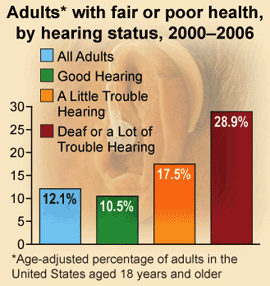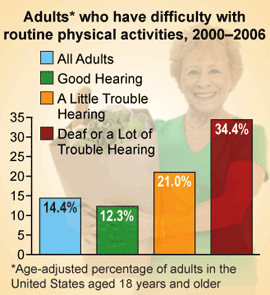Health Status and Routine Physical Activities in Adults by Hearing Status
Modifying health communication for adults with hearing loss may improve their health status and quality of life.

In 2006, 37 million adults in the United States had trouble hearing (ranging from a little trouble to being deaf), representing a substantial increase since 2000 when 31.5 million U.S. adults reported trouble hearing (1,2). Self-reported trouble hearing is a measure of hearing loss that is defined as "the total or partial inability to hear sound in one or both ears" (3). The National Healthy People Objectives for 2010 include goals to reduce prevalence of hearing loss as well as goals to eliminate health disparities among persons with disabilities (4). Accommodations are needed for adults who do not hear well to ensure equal access to health services (5,6). Services mandated by the Americans with Disabilities Act have improved access for this group of Americans, but disparities in access to health care and health information remain (7-9).
Prevalence of fair or poor health status, difficulties with physical functioning, and serious psychological distress increased with degree of hearing loss. Adults who were deaf or had a lot of trouble hearing were about three times as likely as adults with good hearing to be in fair or poor health and to have difficulty with physical functioning (such as walking, bending, reaching, etc). In this report, disparities in selected health status characteristics and health risk behaviors were found by hearing status: adults with hearing loss had poorer health and increased risk of engaging in health risk behaviors than adults with good hearing. The reasons for higher rates of smoking, alcohol use, leisure-time physical inactivity, obesity, and inadequate sleep among adults with hearing loss compared with adults with good hearing cannot be determined from this analysis.
Barriers to optimal medical care for adults with hearing loss have been identified by the medical community and specific suggestions for effectively addressing the needs of these patients have been offered (5-8). Increased attention to the unique health care and health information needs of adults with hearing loss may help reduce disparities identified in this report. Media and other public health campaigns that use auditory techniques to promote healthy behaviors among the U.S. adult population may require modifications to more effectively reach adults with hearing loss. Inclusion of communication modalities appropriate for adults with hearing loss may aid in reducing health risk behaviors in this population.

The National Health Interview Survey (NHIS), a survey of the noninstitutionalized civilian population of the United States, has been an important source of information about health and health care in the United States since it was first conducted in 1957. NHIS is a multistage probability sample survey that is conducted continuously throughout the year by interviewers of the U. S. Census Bureau for the Centers for Disease Control and Prevention's National Center for Health Statistics. For further information see the NHIS website. Questions about hearing status, developed in collaboration with researchers at Gallaudet University, were first asked in the NHIS in 1962-1963 (10). Subsequently, hearing questions were asked in supplement questionnaires in 1970, 1971, 1977, 1990, and 1991 (11-15). Since 1997, questions about hearing status have been asked annually in the NHIS Sample Adult Core questionnaire. Adults are asked "Which statement best describes your hearing without a hearing aid: good, a little trouble, a lot of trouble, deaf?" Annual estimates of the number and percentage of adults with any trouble hearing are available for major population subgroups (1,2,16-20).
References
- Pleis JR, Lethbridge-Cejku M. Summary health statistics for U.S. adults: National Health Interview Survey, 2006. National Center for Health Statistics. Vital Health Stat 10(235). 2007.
- Pleis JR, Benson V, Schiller JS. Summary health statistics for U.S. adults: National Health Interview Survey, 2000. National Center for Health Statistics. Vital Health Stat 10(215). 2003.
- National Library of Medicine. National Institutes of Health. Medline Plus. Medical Encyclopedia. U.S. Department of Health and Human Services. 2008. Available from http://www.nlm.nih.gov/medlineplus/ency/article/003044.htm
- U.S. Department of Health and Human Services. Healthy People 2010. 2nd ed. With Understanding and Improving Health (2 vols). Washington, D.C. U.S. Government Printing Office. November 2000.
- Ebert DA, Heckerling PA. Communication with deaf patients. Knowledge, beliefs, and practices of physicians. JAMA 273(3):227-9. Jan 18, 1995.
- Iezzoni LI, O'Day BL, Killeen M, Harker H. Communicating about health care: observations from persons who are deaf or hard of hearing. Ann Intern Med 140(5):356-62. Mar 2, 2004.
- Barnett S. Clinical and cultural issues in caring for deaf people. Fam Med 31(1):17-22. 1999.
- Barnett S. Communication with deaf and hard of hearing people: a guide for medical education. Acad Med 77(7):694-700. July 2002.
- Tamaskar P, Malia T, Stern C, Gorneflo D, Meador H, Zazove P. Preventive attitudes and beliefs of deaf and hard-of-hearing individuals. Arch Fam Med 9(6): 518-25. June 2000.
- National Center for Health Statistics. Characteristics of persons with impaired hearing, United States, July 1962-June 1963. Vital health Stat 10(35). 1967.
- Schein JD, Gentile A, Haase K. Methodological aspects of a Hearing Ability Interview Survey. National Center for Health Statistics. Vital Health Stat 2(12): 1973.
- National Center for Health Statistics. Current estimates from the Health Interview Survey, United States - 1971. National Center for Health Statistics. Vital Health Stat 10(79). 1973.
- National Center for Health Statistics. Current estimates from the Health Interview Survey: United States - 1977. National Center for Health Statistics. Vital Health Stat 10(126). 1978.
- Adams PF, Benson V. Current estimates from the National Health Interview Survey. National Center for Health Statistics, 1990. Vital Health Stat 10(181). 1991.
- Adams PF, Benson V. Current estimates from the National Health Interview Survey. National Center for Health Statistics, 1991. Vital Health Stat 10(184). 1992.
- Lucas JW, Schiller JS, Benson V. Summary health statistics for U.S. adults: National Health Interview Survey, 2001. National Center for Health Statistics. Vital Health Stat 10(218). 2004.
- Lethbridge-Cejku M, Vickerie J. Summary health statistics for U.S. adults: National Health Interview Survey, 2002. National Center for Health Statistics. Vital Health Stat 10(222). 2005.
- Lethbridge-Cejku M, Vickerie J. Summary health statistics for U.S. adults: National Health Interview Survey, 2003. National Center for Health Statistics. Vital Health Stat 10(225). 2005.
- Lethbridge-Cejku M, Rose D, Vickerie J. Summary health statistics for U.S. adults: National Health Interview Survey, 2004. National Center for Health Statistics. Vital Health Stat 10(228). 2006.
- Pleis JR, Lethbridge-Cejku M. Summary health statistics for U.S. adults: National Health Interview Survey, 2005. National Center for Health Statistics. Vital Health Stat 10(232). 2006.
Data Source: Health Disparities Among Adults With Hearing Loss: United States, 2000-2006.
CDC/NCHS National Health Interview Survey, 2000-2006.


